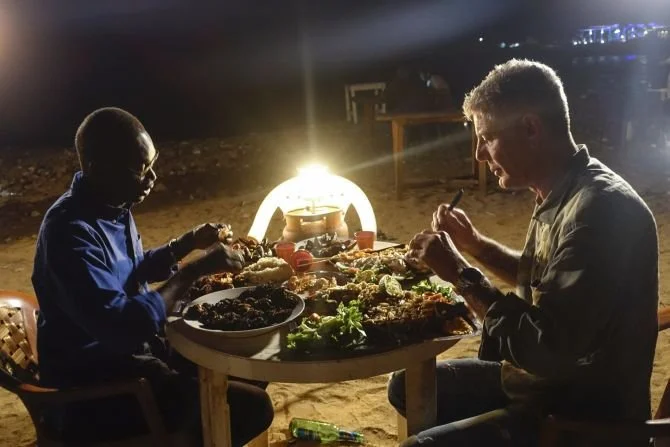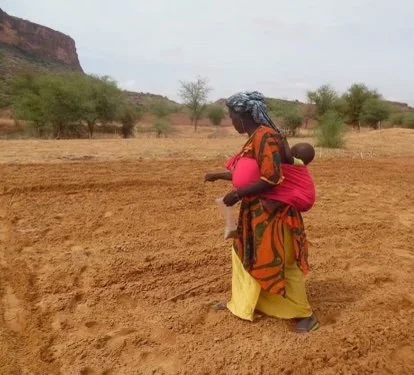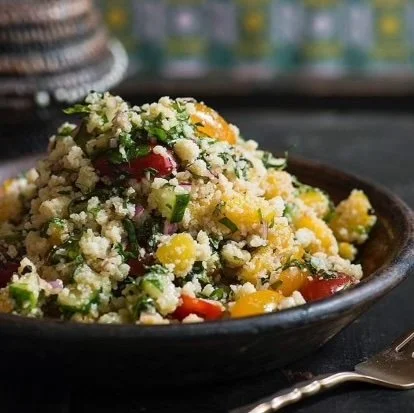The Kitchen and Beyond
Chef Pierre Thiam taken by Sara Costa as seen on https://www.pierrethiam.com/
How one chef, Chef Pierre Thiam, is solving the world’s problems with the “Seed of the Universe”
I first came across Chef Pierre Thiam while watching the late Anthony Bourdain’s Parts Unknown episode on Senegal (Season 7, Episode 6). Pierre sat across Tony as they poured local beer, La Gazelle, into small plastic cups and ate Thioff, “Senegal’s favorite fish,” as Pierre announced—right off the grill at Cour de Cassation Beach in a casual and lively nighttime scene.
Not too humble nor too proud, Chef Pierre Thiam was Tony’s energetic match. There was a noticeable electricity, an easy going camaraderie between the two. Tony’s curiosity only met by Pierre’s excitement to introduce him to his homeland, and the two carried on like old friends.
But I didn’t know anything about the chef, except that Tony jived with the guy, and well, that was enough for me to do some research.
As seen on Parts Unknown
Upon further inspection what I discovered was Chef Pierre Thiam wasn’t just an enthusiastic chef who introduced his native West African cuisine to New Yorkers and authored fundamental Senegalese cookbooks (already a pretty big deal).
No—this man created a sustainable food system that combats food scarcity and desertification all while creating prosperity in the Sahel region of Africa and beyond.
His story began when Pierre came to the United States for college in Ohio. On his way, he stopped in NYC to visit a friend. But three days after his stay, he was robbed—all his money and belongings gone. A major fork in the road, he needed to decide: Would he go back home (he still had his return ticket) or try his hand at living in New York City? What later would seem a turn of fate, he chose to stay in New York.
His first gig was as a busboy in the West Village—a far cry from his trajectory studying physics and chemistry. But it gave him a window into a whole new world. To his astonishment, the kitchen was largely made up of male chefs; something he’d never witnessed back home. In Senegal, only women were seen in the kitchen. And it was then and there that he discovered his true calling.
Step by step he’d climb the upper echelons of the kitchen, make New Yorkers fall in love with West African cuisine, become an executive chef, international restaurateur, and cookbook author.
But even with all of his success, he felt something was missing. He wanted to make a greater impact beyond the kitchen.
The discovery of the “Seed of the Universe”
While doing some research for an upcoming cookbook, he found himself in the remote southeast region of Senegal—Kedougou. There, he rediscovered an ancient grain called fonio. One that hadn’t been a part of the Senegalese diet for ages.
Yet, this grain had been a resilient food source and cornerstone all across Africa for over 5,000 years. Found in tombs from ancient Egypt, it was deeply revered, which further piqued the chef's interest.
A mystical food source, he found out that everywhere it had been grown, there was a myth or superstition about it. The Dogon culture in Mali called it “Po,” or the “Seed of the Universe.” Fonio is also known as the dish for the royals in Kedougou.
And in a region prone to drought, fonio thrives.
This is everything when “hunger levels are higher in Sub-Saharan Africa than anywhere else in the world,” as Pierre discusses in his famous TED Talk (“A forgotten ancient grain that could help Africa prosper”).
A multi-prong solution to the world’s problems
More research revealed this grain had the potential to solve not just food scarcity because of its ability to thrive in poor soil conditions with little water, but to stave off desertification with its deep roots restoring carbon dioxide in the soil.
Furthermore, creating a food system based in the region would mean more prosperity and a better quality of life for those living there. Thus, fewer young people would take that deadly and unfortunate journey across the Atlantic seeking opportunity.
And this isn’t even touching the potential effects on consumers—buying a conscious product and digesting a nutrient-dense food source; a diversified diet offering nourishment that many other grains don’t, including the two amino acids methionine and cysteine. It’s gluten-free, full of fiber, and has a low glycemic index to boot.
So Pierre did just that—he came up with a model that could amplify the use of this grain and bring prosperity to the region and beyond—providing a model of sustainability for the rest of the world.
Upon further inspection what I discovered was Chef Pierre Thiam wasn’t just an enthusiastic chef who introduced his native West African cuisine to New Yorkers and authored fundamental Senegalese cookbooks (already a pretty big deal).
No—this man created a sustainable food system that combats food scarcity and desertification all while creating prosperity in the Sahel region of Africa and beyond.
His story began when Pierre came to the United States for college in Ohio. On his way, he stopped in NYC to visit a friend. But three days after his stay, he was robbed—all his money and belongings gone. A major fork in the road, he needed to decide: Would he go back home (he still had his return ticket) or try his hand at living in New York City? What later would seem a turn of fate, he chose to stay in New York.
His first gig was as a busboy in the West Village—a far cry from his trajectory studying physics and chemistry. But it gave him a window into a whole new world. To his astonishment, the kitchen was largely made up of male chefs; something he’d never witnessed back home. In Senegal, only women were seen in the kitchen. And it was then and there that he discovered his true calling.
Step by step he’d climb the upper echelons of the kitchen, make New Yorkers fall in love with West African cuisine, and become an executive chef, international restaurateur, and cookbook author.
But even with all of his success, he felt something was missing. He wanted to make a greater impact beyond the kitchen.
The discovery of the “Seed of the Universe”
Woman planting fonio in the Sahel region, as seen @ChefPierreThiam
While doing some research for an upcoming cookbook, he found himself in the remote southeast region of Senegal—Kedougou. There, he rediscovered an ancient grain called fonio. One that hadn’t been a part of the Senegalese diet for ages.
Yet, this grain had been a resilient food source and cornerstone all across Africa for over 5,000 years. Found in tombs from ancient Egypt, it was deeply revered, which further piqued the chef's interest.
A mystical food source, he found out that everywhere it had been grown, there was a myth or superstition about it. The Dogon culture in Mali called it “Po,” or the “seed of the universe.” Fonio is also known as the dish for the royals in Kedougou.
And in a region prone to drought, fonio thrives.
This is everything when “hunger levels are higher in Sub-Saharan Africa than anywhere else in the world,” as Pierre discusses in his famous TED Talk (“A forgotten ancient grain that could help Africa prosper”).
A multi-prong solution to the world’s problems
More research revealed this grain had the potential to solve not just food scarcity because of its ability to thrive in poor soil conditions with little water, but to stave off desertification with its deep roots restoring carbon dioxide in the soil.
Furthermore, creating a food system based in the region would mean more prosperity and a better quality of life for those living there. Thus, fewer young people would take that deadly and unfortunate journey across the Atlantic seeking opportunity.
And this isn’t even touching the potential effects on consumers—buying a conscious product and digesting a nutrient-dense food source; a diversified diet offering nourishment that many other grains don’t, including the two amino acids methionine and cysteine. It’s gluten-free, full of fiber, and has a low glycemic index to boot.
So Pierre did just that—he came up with a model that could amplify the use of this grain and bring prosperity to the region and beyond—providing a model of sustainability for the rest of the world.
How it works
Chef Pierre Thiam contracts small farmers to provide the raw materials, guaranteeing their crops will be purchased. With the strong prerogative that the small farmer is the “ultimate beneficiary” and that the crops are protected for the region. Describing the initiative as “small farmers to the fork.”
Then the grain is acquired by Sustainable African Foods, a partnering mill in Mali. This is in addition to other crops that are run through the mill as a way to rotate and prevent monoculture.
After which, the chef’s food distribution company, Yolélé West Africa, located in Senegal, distributes the products throughout West Africa, the US, and Europe.
Said to have a delicately earthy and nutty flavor, Yolélé sells fonio pilaf, fonio chips, spices, and more —which can be found at places like Whole Foods, Target, Amazon, and Sprouts.
A number of breweries around the world have also jumped on board wanting to make a conscious impact and have begun using the magical grain to brew their beer (as opposed to the usual wheat or barley). Such breweries include Brooklyn Brewery, Carlsberg, and Guinness among several others.
The chef (slash "food ambassador") breaks his revolutionary enterprise down as follows:
“[It’s] A model of development for rural Africa by using their own products and creating a demand for it.”
Chef Pierre Thiam's fonio salad, as seen on @ChefPierreThiam
Worldwide Implications
As we’ve always known, food gives life. Food is the SOURCE.
Chef Pierre Thiam promotes investment in these “lost crops” as a way of salvaging civilization.
And his model teaches us that addressing the underutilization of crops and tapping into ancient practices has the potential to create multi-prong solutions and ripple effects all across the globe.
Like Chef Thiam says, "There are a couple of thousands of crops, like fonio, waiting to be unlocked in Africa.”
Additional investment from large food corporations in African crops or in other remote locations around the world could mean cleaner air, a better diet, elimination of food scarcity, and better livelihood for all.
In closing, Pierre Thiam once said, “I I don’t know how to ever thank the person who stole my money. You know, without that experience, I don’t know if I’d ever be where am today."
I think it's safe to say we'd also like to thank that guy who robbed you.
Because in his goal of “One step closer to the Universal civilization,” as he says in his TED Talk, he’s taken a giant leap for humankind.
Discover more about Pierre Thiam’s life-giving initiatives: @chefpierrethiam and support the cause by purchasing Yolélé products at major grocery stores or https://yolele.com/
Sheena Steedman is a Lifestyle Writer & Journalist—telling the stories that matter most



